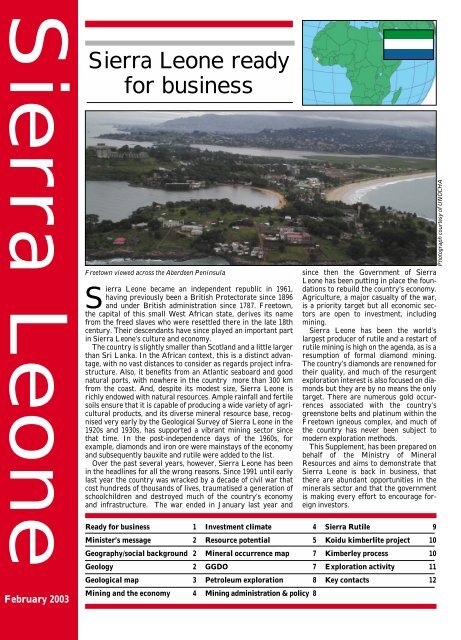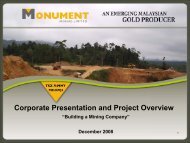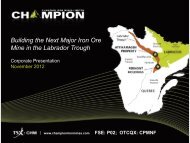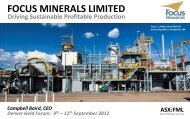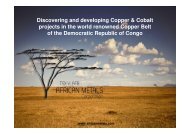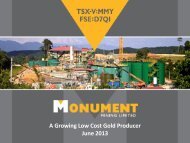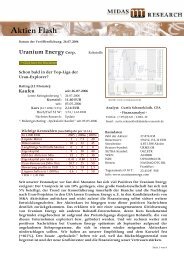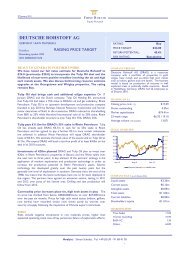Sierra Leone ready for business - Cream Minerals Ltd.
Sierra Leone ready for business - Cream Minerals Ltd.
Sierra Leone ready for business - Cream Minerals Ltd.
- No tags were found...
Create successful ePaper yourself
Turn your PDF publications into a flip-book with our unique Google optimized e-Paper software.
RESOURCE POTENTIALdeposit. Also, substantial quantities ofrutile occur in the gravels of the LittleScarcies River, around the confluencewith the Mabole River in Kambia/PortLoko Districts, and as an accessory mineralin the high-grade gneisses of theKasila Group.The Gbangbama group consists of atleast six major mineral sands deposits:Mogbwemo, Bamba-Belebu, Pujubu,Lanti, Gbeni and Gangama. The firstthree deposits of the Gbangbama grouphave now been almost completely minedout. Mining has also taken up about 30%of the Lanti deposit but the remainderare in various stages of mine feasibilitystudy and could be classified as mineable.Gold: First discovered in <strong>Sierra</strong> <strong>Leone</strong> in1926 in the Makoke River near Masumbiri,northern <strong>Sierra</strong> <strong>Leone</strong>, further prospectingbetween 1928 and 1930 proved the existenceof extensive alluvial goldfields in theSula Mountains/Kangari Hills in the northand central parts of the country.All greenstone belts in <strong>Sierra</strong> <strong>Leone</strong>(with the possible exception of theMarampa Group) are known to containgold. Rivers and streams draining theseareas also carry gold. Prospecting activitiesby the Geological Survey establishedthe existence of gold in the followinglocalities within the granite-greenstoneterrain of <strong>Sierra</strong> <strong>Leone</strong>:1. The Sula Mountains area includingLake Sonfon, Maranda and Yirisen.2. The Kangari Hills area especiallyBaomahun, Makong and Makele.3. The Nimini Hills.4. The Loko Group Schist belt in theKamakwie-Laminaia area, northern<strong>Sierra</strong> <strong>Leone</strong>.5. The Gori Hills.Lode gold deposits occur in the LakeSonfon area, at Kalmaro, Makong,Baomahun and Komahun. Other goldbearingareas within the granite-greenstoneterrain include the Kangi Hills andthe Kambui Hills.The Lake Sonfon area contains steeplydippingquartz and pegmatite veinsshowing sulphide mineralisation and gold,with assay values of up to 32 g/t. AtKalmaro, mineralised quartz veins andlenses intruding talc-chlorite-carbonateschists have been traced <strong>for</strong> about 800 malong strike and assay up to 27 g/t.In the Makong area, quartz veins, veinletsand stringers, sometimes with visible gold,occur in the upper reaches of the Kwifwifwistream. Further exploration in the Makongarea has revealed an extensive system of mineralisedquartz veins arranged en echelon.At Baomahun, the gold mineralisationis also associated with sulphides and followsthe contact between magnetite-richgarnet-cummingtonite schists andcordierite schists. The contact zone isabout 100 m wide and extends <strong>for</strong> about1,500 m. The Baomahun deposit, mined inthe 1950s by Maroc Mining, has been thesubject of several studies, with HarryWinston Inc. installing a pilot heap-leachpad in 1990 and driving an adit into thehillside.At Komahun in the Nimini Hills, significantgold mineralisation occurs over anarea of about 400 m x 100 m. Drill coreassay values of up to 34 g/t and averagingabout 8.6 g/t over 20 m have beenobtained. Geological Survey studies havedelineated significant geochemical anomalies,and Mano River Resources andAfcan Mining are about to start explorationin the area.Bauxite: The occurrence of bauxite in<strong>Sierra</strong> <strong>Leone</strong> was first recorded in 1920and 1921 on the road from Falaba to Waiain northern <strong>Sierra</strong> <strong>Leone</strong>. Other bauxiteoccurrences include those betweenMoyamba and Mano (weathered doleritesills of the Rokel River Group); thebauxite deposits of the FreetownPeninsula; the Krim-Kpaka deposits inSIERRA RUTILE LIMITEDWorking <strong>for</strong> a better <strong>Sierra</strong> <strong>Leone</strong>Telephone: 232 22 225316Fax: +232 22 223448Email: srlfree@sierratel.sl<strong>Sierra</strong> Rutile is proud to be a part of thereconstruction of <strong>Sierra</strong> <strong>Leone</strong>. It hasdemonstrated its confidence in the futureof <strong>Sierra</strong> <strong>Leone</strong> by ensuring significantpresence throughout the war years. Welook <strong>for</strong>ward to a restart and revitalisationof the <strong>Sierra</strong> <strong>Leone</strong> economy.Address:-Guma BuildingLamina Sankoh StreetFreetown<strong>Sierra</strong> <strong>Leone</strong>6
SIERRA RUTILE<strong>Sierra</strong> RutileMIL (Investments) SARL (MIL) and USTitanium own 75% and 25% respectivelyof <strong>Sierra</strong> Rutile <strong>Ltd</strong> (SRL). SRL uses abucket ladder dredge to mine mineralsands in the southern part of <strong>Sierra</strong><strong>Leone</strong> near the Imperri Hills some 30 kmfrom the sea, on the low-lying coastalplain about 135 km south-east of the capitalFreetown.Until January 1995, SRL producedabout 25% of the world’s rutile (TiO 2 ), thepreferred feedstock <strong>for</strong> making titaniumdioxide pigments. Another product isilmenite (FeO.TiO 2 ) which is a lowerquality titanium ore. Potential <strong>for</strong> zirconrevenues also exists given acceptablemarket conditions.Since the inception of mining in the projectarea in 1967, operations have beensuspended twice <strong>for</strong> economic reasons –in 1971, as Sherbro <strong>Minerals</strong>, after beingmanaged by Pittsburgh Plate Glass Co.,and in 1982 under Bethlehem Steel Corp.The operation has been on a soundfooting since the assumption of total ownershipby Nord Resources Corp. of theUS in 1982, through to ConsolidatedAerial view of SRL’s dredge and wetprocessing plant.Rutile <strong>Ltd</strong> (CRL) of Australia becoming ajoint owner in November 1993, until thecessation of operations in January 1995<strong>for</strong> security reasons. MIL acquiredNord’s 50% interest in October 1999 andon May 1, 2001, MIL and US Titaniumacquired the 50% interest held by CRL.President Kabbah <strong>for</strong>mally declaredthe rebel war in <strong>Sierra</strong> <strong>Leone</strong> at an end onJanuary 18, 2002, and the state of emergencywas lifted on March 1, 2002.Presidential and Parliamentary electionstook place on May 14, 2002, with the reelectionof President Kabbah. Thesteadily improving political and securitysituation in <strong>Sierra</strong> <strong>Leone</strong> has enhancedSRL’s prospects <strong>for</strong> keeping to the currentschedule <strong>for</strong> minesite rehabilitationto start in April 2003 leading to resumptionof production in January 2004.The SRL mine is a robust operationcommercially, technically and financially.Mano River Resources IncPIONEER andINNOVATORin <strong>Sierra</strong> <strong>Leone</strong>Dedicated to exploration and responsible developmentof gold and diamondsTraded on AIM (MANA) in London and the Toronto Venture Exchange (MNO)email: mano@manoriver.com website: www.manoriver.comLocal Office: GOLDEN LEO RESOURCES LTD24 Charlotte Street P O Box 564 FreetownTel: +232 22 227 467UK Office: MANO RIVER RESOURCES INCSuite One 12 Station Road Didcot OX11 7LL UKTel: +44 (0)1235 810 740 Fax: 810 7339
EXPLORATION ACTIVITYIt is now estimated that US$8.4 millionwill be required to bring the mine intocommercial production, with an additionalUS$3.1 million of working capital.In order to secure the funding required,in June 2002 DiamondWorks entered intoa joint venture agreement with MagmaDiamond Resources <strong>Ltd</strong>, a British VirginIslands company whose shareholders areBenny Steinmetz Group International,Bateman <strong>Minerals</strong> (Pty) <strong>Ltd</strong>, SteinmetzDiamond Group International andEkuseni Resources. The Koidu JV participantswill provide technical and marketingexpertise, as well as contributingto equity and debt financing.Last year, Bateman <strong>Minerals</strong> (Pty) <strong>Ltd</strong>was approached to conduct a site visit witha view to completing a detailed engineeringanalysis, Badger Mining and Consulting(Pty) <strong>Ltd</strong> was commissioned toundertake a mine design exercise andAfrican Explosives <strong>Ltd</strong> was approachedto determine an initial blast design.The project, as envisaged, has a 3.5-yearlife but resources are deemed sufficient toextend the project life. The project is consideredto be robust at discount rates thatwould recognise the inherent risks associatedwith the country and the company.Branch Energy’s exploration plans <strong>for</strong>2003 include the exploration of the Upperand Middle Sewa alluvial properties.Attention will also be focused on the potentialof a nearby palaeo channel. The Matemuproperty will be investigated by airbornegeophysics to detect the presence of kimberlitebodies. Area 7, near Koidu, will bereviewed <strong>for</strong> action in the following year.Mano RiversuccessMano River Sources, Inc. is a Canadianexploration company listed on the TSX-Vand traded on the London AIM exchange.The company holds gold and diamondlicences in <strong>Sierra</strong> <strong>Leone</strong>, Liberia andGuinea, having started exploration andlicence acquisition as a private companyin 1995.Diamonds: The completion of the disarmamentprocess in <strong>Sierra</strong> <strong>Leone</strong> inJanuary 2002 enabled Mano to commencea reconnaissance indicator mineralsurvey across its Yengema and N’JaiamaExclusive Prospecting Licences (EPLs)in the Kono diamond district.It has since quickly discovered two previouslyunmapped kimberlite dykes, designatedLion-1 and Lion-2, both of whichhave yielded macro-diamonds and havebeen mapped discontinuously alongstrike <strong>for</strong> 5 km and 6 km, respectively.Kono, a focus <strong>for</strong> explorationMano has suggested a minimum grade <strong>for</strong>Lion-1 of 0.65 ct/t based on recoveriesfrom a. 1.7 t mini-bulk sample of kimberlitematerial, which included significantunavoidable dilution by granite. Thesample yielded 22 diamonds (the largestbeing 0.32 ct and gem quality) <strong>for</strong> a totalweight of 1.15 ct from the +0.71 mm sizefraction.Mano has discovered kimberlite floatindicative of a pipe rather than a dyke andlocated kimberlite in as many as 18 separatelocalities within its EPLs. Many kimberliteoccurrences are reported to coincidewith significant artisanal diamondworkings and high interest indicator mineralchemistry. In 2003, the company willtest the economic potential of the Liondykes, while follow-up work will continueelsewhere to identify further kimberlites.It strongly believes that some of thesekimberlites may prove economic and bethe sources of some of the spectacularlylarge gem diamonds recently recoveredfrom the immediate area of Mano’s EPLs(<strong>for</strong> example, an officially reported 110 ctstone and two unofficially reported stonesweighing 400 ct and 1,400ct).Gold: in May 2002, Mano announcedthe signature of a Heads of Agreementwith Golden Prospect plc <strong>for</strong> joint explorationof their contiguous licences at LakeSonfon. The Sonfon area within the SulaMountains greenstone belt has traditionallybeen one of <strong>Sierra</strong> <strong>Leone</strong>’s richestand most productive <strong>for</strong> gold. Previouswork by the partners on their respectivelicences includes regional geochemistrythat has identified gold targets related tomajor shear structures in areas withextensive artisanal workings. A grabsample from a mineralised shear zonenear Dalakuru recorded 2,388g/t of gold,Photograph courtesy of UNOCHAwith significant lead, silver, zinc, copperand nickel values. Mano is currentlyundertaking a regional geochemistry andtrench sampling programme, with resultsexpected by March 2003.All the streams draining the Niminigold licence are reported to carry gold,while diamonds are also reportedly minedartisanally, along strike from the Konokimberlite dyke swarm. Previous geochemicalwork on the Nimini gold licencehas identified a 4km x 0.5km gold andbase metal anomaly, associated withmajor zones of shearing.ADH poisedAfrica Diamond Holdings <strong>Ltd</strong> (ADH), aCanadian diamond exploration company,holds a major, 14,500 km 2 land positionprospective <strong>for</strong> diamondiferous kimberlite,alluvial diamonds and preciousmetals. This is the largest land area heldby an exploration company in <strong>Sierra</strong><strong>Leone</strong>. ADH established a Freetownoffice in 1996 and secured 12 exclusiveprospecting licences late that year and inearly 1997. The Ministry of MineralResources has recently confirmed all ofthem and the company is now poised torecommence operations. The strategy istwo-fold: to discover one or more worldclassdiamondiferous kimberlite pipeswithin the large, regional 12,900 km 2Exclusive Prospecting Licence area; andto advance large-scale alluvial targets toproduction decisions, with a view to generatingnear-term cash flow.As a first step, a high-resolution, airbornemagnetic geophysical survey is tobe flown over ADH’s entire licence portfolio.The survey will be flown at 60 mdrape height, with flight lines flown in 100m centres. Crew and equipment mobilisationhave commenced, with data acquisitionexpected to be under way thisquarter. Landsat imagery, geological andstructural interpretations, data processing,ground sampling and trenchingwill be incorporated into the explorationprogramme and conducted concurrentlywith the airborne survey. The company’scontractor will undertake same-day processingof all survey data. The survey isalso expected to provide valuable in<strong>for</strong>mationon the potential <strong>for</strong> precious andbase metal deposits throughout thislarge, unexplored region.ADH’s alluvial diamond thrust willinclude sampling its six Sewa River arealicences (Sumbuya, Kasama, Baoma,Maina, Madina and Gembo), which covera significant part of this historically productiveriver. The licences also host eighttopographic depressions that will be sam-11
KEY CONTACTSpled to determine if they represent diamond-bearing kimberlites.The company’s 12,900 km 2 regional licence blankets northeastern<strong>Sierra</strong> <strong>Leone</strong> and is highly prospective <strong>for</strong> the discoveryof marginally eroded kimberlite pipes and dykes, as well as preciousand base metals. Four licences (Tefeya, Peyima, Kundiyiand Mansayi) are adjacent to this regional licence and possessboth kimberlite and large-scale alluvial potential. Ground samplingwill be conducted on all of these licences after a review of theairborne survey data.KEY CONTACTSMINISTRY OF MINERALRESOURCESMinister’s OfficeYouyi BuildingBrookfieldsFreetownTel:+232 22 240142/241147Fax:+232 22 242107Email: director@sierratel.slPermanent SecretaryYouyi BuildingBrookfieldsFreetownTel: +232 22 240172Fax: +232 22 240172Director of MinesYouyi BuildingFreetownTel: +232 22 240420/240467Fax: 232 22 240467Email: director@sierratel.slDirector Geological SurveyNew EnglandBrookfieldsFreetownTel: +232 22 240740Fax: +232 22 241936Email: geological-_survey@ yahoo.com<strong>Sierra</strong> <strong>Leone</strong> Chamber ofCommerceGuma BuildingLamina Sankoh StreetTel: +232 22 226305Fax: +232 22 220085Email: cc@sierratel.slGGDOBank of <strong>Sierra</strong> <strong>Leone</strong>BuildingGlaucester Street, FreetownTel: +232 22 222600Fax: + 232 22 229064Email: ggdo@sierratel.slThis Supplement is sponsored by DFID, the international development wing of the UK Government,<strong>Sierra</strong> Rutile <strong>Ltd</strong> and Branch Energy <strong>Ltd</strong>, and has been produced on behalf of the <strong>Sierra</strong> <strong>Leone</strong>Ministry of Mineral Resources.Published byTHE MINING JOURNAL LTD60 Worship Street, LondonEC2A 2HDTel: +44 (0) 7216 6060. Fax: +44 (0) 7216 6050Edited in London by Roger Ellis based on material prepared in Freetown by Usman Boie Kamara,Deputy Director of Mines, and Mohamed Bundu Mansaray, Deputy Director of the Geological Survey.Mining Journal <strong>Ltd</strong> publishes a number of supplements each year as part of a subscription packageto the weekly Mining Journal, monthly Mining Magazine and Mining Annual Review.Annual subscription: £284/Euro 505 in the UK and Europe, and US$497 elsewhere.Subscription Dept:PO Box 10, Edenbridge, Kent TN8 5 NE UKTel: +44 (0) 1732 864333 Fax: +44 (0) 1732 865747E-mail: subscriptions@ mining-journal.com© Mining Journal 2003Designed by Sheldon Mann Associates, LondonPrinted by Friary Press, Dorchester, Dorset, UK12
GONDWANAGONDWANA (INVESTMENTS) SABoulevard Royal 25 B24 Charlotte StreetL-2449 Luxembourg, Freetown, <strong>Sierra</strong> <strong>Leone</strong>Grand-Duchy of Luxembourg Tel: +232 22 224 993Tel: +352 222512 Fax: +232 22 225227Fax: +352 222413E-mail: gondwana@sierratel.slGondwana is a privately-ownedinvestment and mineral explorationcompany based in Luxembourgand owned by Jean-RaymondeBoulle. Mr. Boulle was the founder andco-Chairman of Diamond FieldsResources Inc., the company thatdiscovered the world famous Voisey’sBay nickel deposit in Canada.The director <strong>for</strong> exploration <strong>for</strong>Gondwana, Mark Collins oversees theexploration programme, together with theexploration manager in <strong>Sierra</strong> <strong>Leone</strong>,Craig McLean and the administrationmanager John Sisay.The company currently holds seven diamondexploration licences. One of thelicences in the southeastern part of thecountry hosts several kimberlites and,later this month, the company plans to takesamples of these kimberlites <strong>for</strong> causticdissolution, micro/macro diamond analysis.A stream-sediment sampling programmehas been completed throughout thelicence, as a follow up to earlier remotesensing work, and results are pending.The remaining six licences are locatedin the central and northwestern parts of<strong>Sierra</strong> <strong>Leone</strong>. The central licence islocated within a prolific kimberliteprovince and has significant artisanal diamond-miningactivity. The preliminarystream-sediment sampling results fromthis licence are extremely encouragingand indicate a high probability of proximalkimberlites.The company is currently engaged instream-sediment sampling work on itstwo licences in the northwest and hasthree geologists in the field conductingthis work.Gondwana has taken hundreds of samplesin <strong>Sierra</strong> <strong>Leone</strong> over the past fewmonths and intends to continue with thiswork, together with follow up, <strong>for</strong> the balanceof the dry season. Typically, intenserainfall in <strong>Sierra</strong> <strong>Leone</strong> from the monthsof May through October precludes accessto stream sediments and the companythere<strong>for</strong>e intends to continue to takeadvantage of the short field season tocomplete this work. All samples takenfrom within the country are processed atthe company’s newly-completed diamond-processing laboratory in Freetown.The diamond laboratory is equippedwith magnetic separation facilities comprisinga high-intensity, induced-rollmagnetic separator, an elutriation columndevice (in place of heavy liquids), microscope,rare-earth, high-intensity permanentmagnets, screens, etc.To date, Gondwana is the only explorationcompany that has invested in a diamondlaboratory within the country. Thisfacility should significantly improve the‘turnaround’ time taken from sampleabstraction to final result. The laboratoryalso adds to in-country expertise througha programme of training local personnel,including one geologist, in techniquesassociated with heavy mineral processing.Gondwana has demonstrated its beliefin the continued stability of <strong>Sierra</strong> <strong>Leone</strong>by investing heavily in exploration andplaying a central role in the rejuvenationof the mining sector in this country.<strong>Sierra</strong> <strong>Leone</strong> Supplement, Mining Journal February 200313


